Burnt Honey Is Back! Was It Ever a Thing?
And a recipe for Ride or Die Creamy Coconut Rice... plus a bonus recipe for a Spicy Spin
This week’s newsletter is about rice, and so it’s also about rice rinsing (that is, the act of rinsing the starch off of rice until the water runs clear). And because rinsing rice results in (perfectly good) water down the drain, this is now also a newsletter about my childhood and the fanatical way in which I was raised to treat water like liquified diamonds during California’s drought-saddled years of the 80’s and 90’s.
As such, the Singley house had an addition to its decor: plastic, gallon-sized milk jugs littered around the back deck, the front porch, and throughout the hallways. They’d sit empty in the entryway, ready to go up to the bathrooms for collecting runoff water from showers and baths. And they’d sit full at the top of the stairs, ready to go down to the garden to water the groundcover, blackberry bushes, and my mom’s begonias. And on and on it went. Rinse and repeat.
Hold this thought…
WELL-INTENTIONED
The plan for this week’s NOODLE was a simple one: to formally develop and share my ride-or-die method for making coconut rice, which up to this point I had always just done by feel. No biggie!
This recipe was originally slated to pair with the Calabrian chile oil chicken from last week, but I decided it deserved an isolated moment of glory. I think the method I use makes for a better coconut rice: creamier and coconuttier.
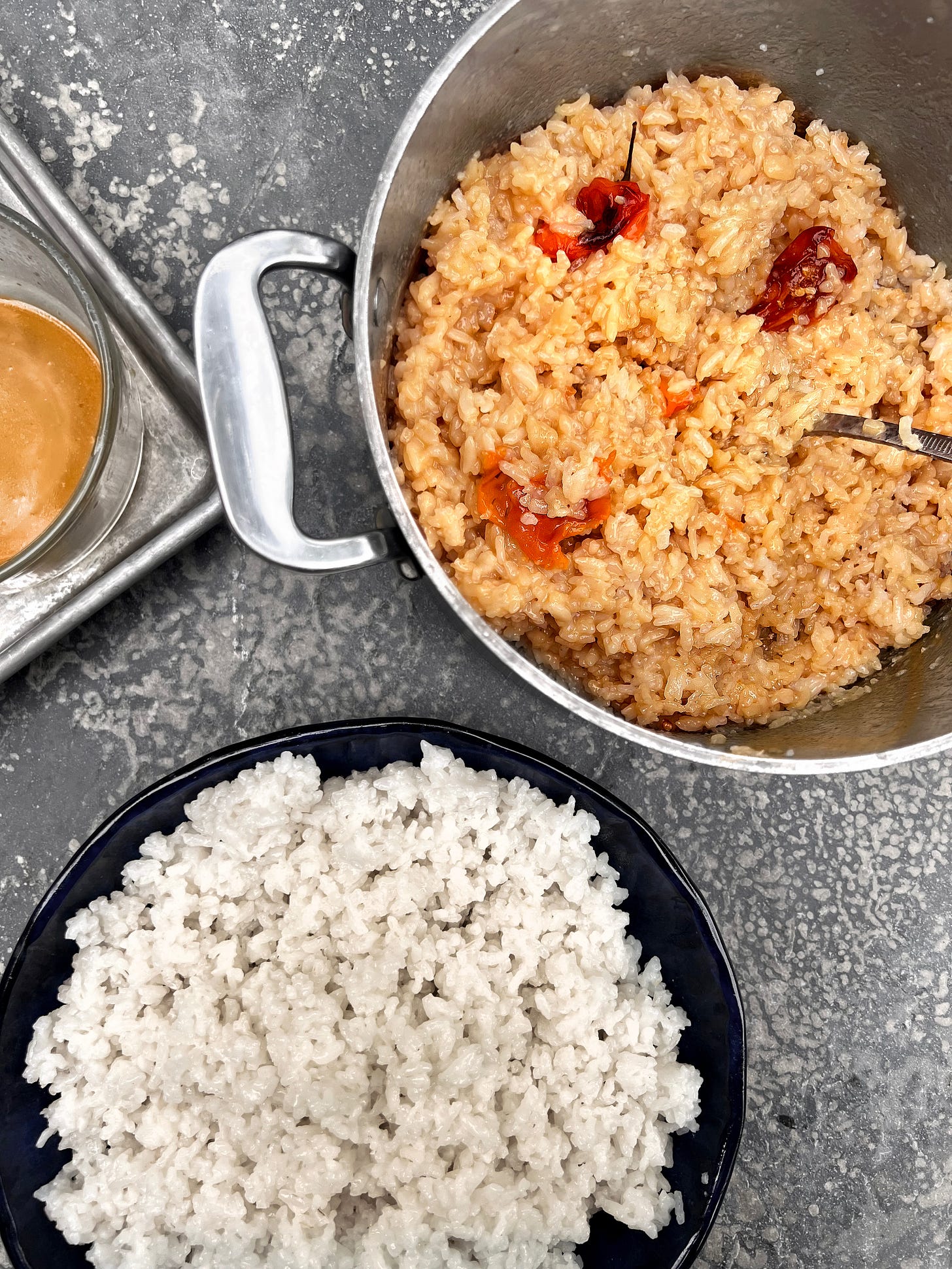
Because each type of rice and each brand of coconut milk perform in wildly different ways, I decided that rather than simply write down my method, I would deliver a master recipe with more universality that could be applied to every rice and every coconut milk, with a formula that would compute water ratios and cooking times based on rice type. So, I started testing everything: rices (is that a word?), milks, rinsing rice vs. soaking rice, more water, less water, Smartwater, rosewater. And then…
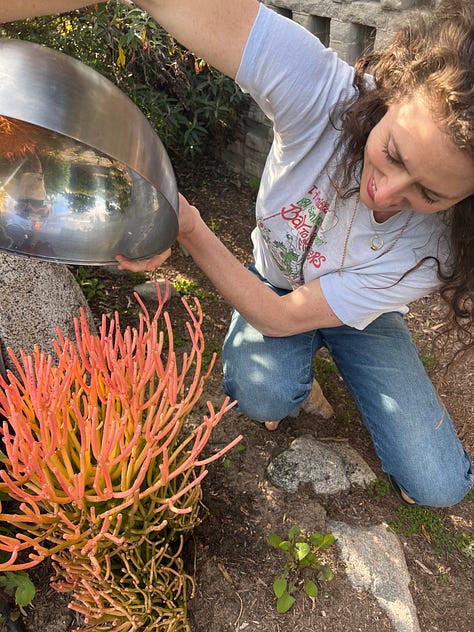
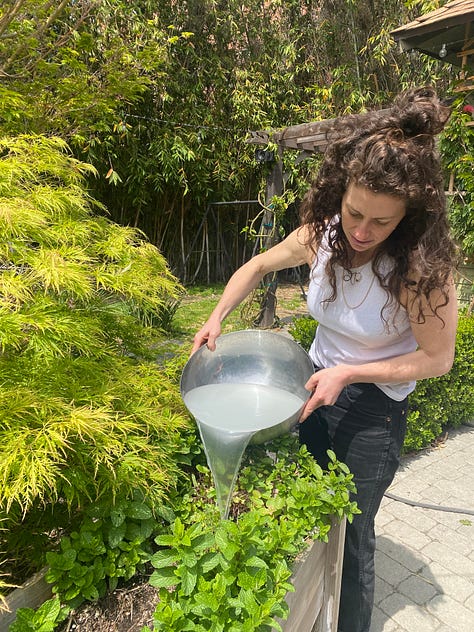

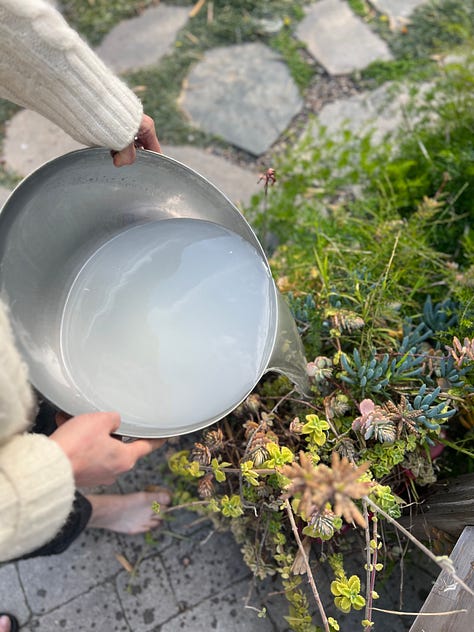
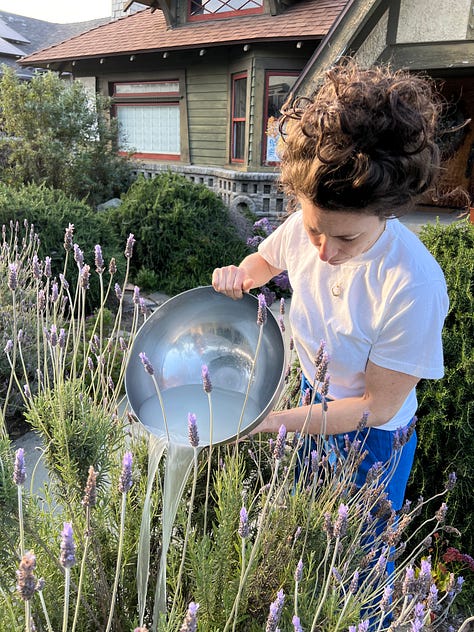

It was when I was saturating the succulents with their 3rd helping of (perfectly good) rice rinsing water that I knew I had to stop cooking.
The task of delivering a one-size-fits-all recipe, proclaiming its preeminence, had become colossal.
So I made the heartbreaking choice to put the noodling to bed with the bathwater. And SIMPLIFY.
What I (and now you) have:
A pretty luxurious coconut rice recipe, employing the method that got me started on this journey in the first place.
POTATOES, POTAHTOES
The well-known method: The first 74 Google results for “coconut rice recipe” and the pile of cookbooks I referenced instruct to make coconut rice by first mixing water and coconut milk, adding rice, and steaming, thereby essentially cooking the rice in the coconut milk. I used to make coconut rice this way, too.
And here’s how I want you to try making it: Steam the rice by cooking it in water only, and fold in the coconut milk at the end.
Applying this method— that is, adding coconut milk post-rice steam— certainly can’t be my invention, but from what I’ve (frankly not) seen, this isn’t the go-to approach. Adding coconut milk to cooked rice is sometimes done in the sticky rice (that is, glutinous rice) world, which admittedly is an entirely different planetsphere. Do you make coconut rice this way, or have you used this technique before? Drop a note in the comments and tell me everything.
DISCLAIMER-VILLE
I haven’t tested every single kind of rice, coconut milk, or cooking method. Have a pressure cooker? Give it a try. Or a rice cooker? Go for it. Noodle on your own, and let the rest of us know what you turn up.
A WORD ON RICE
I developed this recipe for short or medium grain rice. Those bouncy, pudgy little grains fill out even more with the addition of the coconut milk, but still retain a great bite. Love basmati or jasmine? Me, too. Sure, they work in this recipe, but I really prefer the chew of a short grain sushi rice or my favorite these days, Calrose rice, which is technically defined as medium-grain. I like the Botan brand quite a bit.
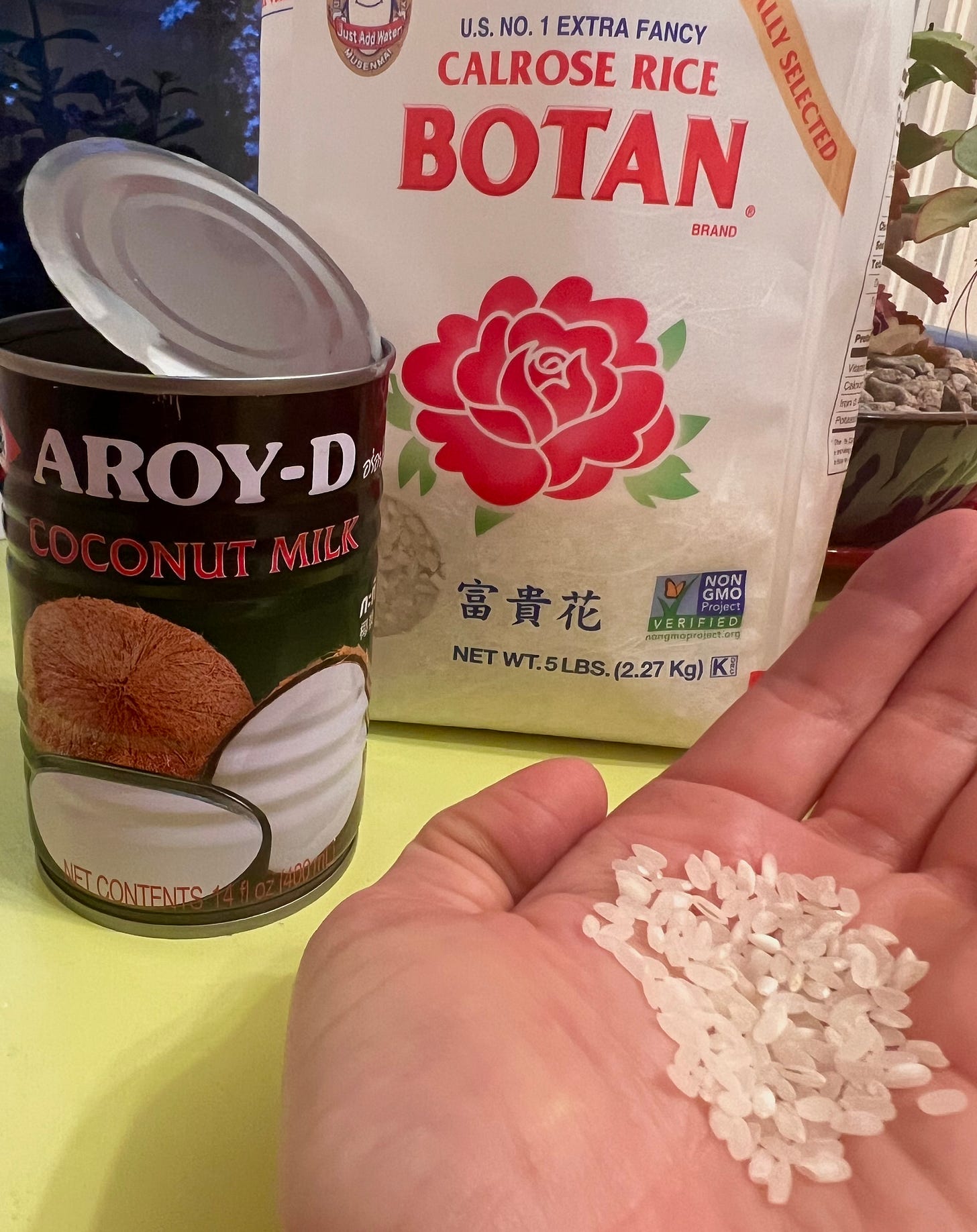
RIDE OR DIE… BUT WHY?
If you have 15 minutes, you can experience for yourself why this method is so right from a visceral perspective. There’s just something about folding rich coconut milk into rice that is already warm and plump– you can see the grains absorbing the milk, and then…. NOT absorbing it. In my mind, what’s happening is the following: the rice granules soak in all of the milk that they can, and when they’ve reached capacity, the excess creates a residual creaminess. If you squint your eyes and tastebuds, the result is somewhat reminiscent of a thick rice pudding.
There’s also more of an impact of fresh coconut on the palate. Think about it: you’re tasting the coconut milk in a purer state because it’s neither cooked off nor cooked into the rice.
THE MORNING AFTER
If you’re someone who cooks extra in order to have leftovers, this is the one for your Tupperware. Miraculously, the rice is super soft the next day, and is even delicious COLD. Any card-carrying rice reveler knows that this is never the case with leftover rice, too frequently relegated to the back of the fridge or to lofty (unrealized) plans to make fried rice.
TIPS AND TRICKS
Use a coconut milk that you like the taste of. While a sub-par coconut milk can skirt by in the method of cooking rice in the milk, there’s less room for error when you add coconut milk post-steaming. Think of how you use great olive oil in a salad dressing versus using one that’s less expensive for cooking. You can’t hide it!
Don’t use “Lite” coconut milk. (And why do they spell it that way?!)
Shake your coconut milk cans like ya mean it to make sure the milk is super smooth! Especially if cans are cold, you’ll find that the coconut cream may rise to the top. If your coconut milk has separated, put it in a bowl and whisk until smooth before measuring and using.
TRY IT PLAIN, AND THEN TRY THIS: COCONUT RICE WITH BURNT HONEY, HABANERO, AND VINEGAR
I couldn’t just give you one recipe. Here’s my new obsession:
Take less than 5 minutes and morph the so-called “original” coconut rice into something sweet, bright, and spicy in the best way: Cook down some honey with halved habaneros. When the honey turns dark amber, it’s nearly caramelized. Deglaze with rice wine vinegar (ugh, at this point, yes, the mixture is called a gastrique, but I swear it sounds more pretentious than it tastes) and then add to the coconut milk.
When the rice has cooked, fold in this feisty, caramel’ed coconut mixture and sprinkle with flaky salt. If you’ve ever made honey butter to go with your cornbread, there’s something here that tickles that flavor memory.
Do you want to add grated ginger? Peanuts? Cilantro? Mint? Great. This variation is a base recipe that’ll pair with a ton of savory dishes– or make a great dessert for people who don’t love crazy sweet things. Take it in a million trillion directions.
WHAT DO YOU MEAN BY “SPICY IN THE BEST WAY?”
Developing this recipe formalized something for me that I’ve been having feelings about for awhile but have never put into words: I kind of want to develop with habaneros exclusively from now on. You can control the heat more easily because there’s less variation from chile to chile. If you add a quarter of a habanero one week, a quarter of one the next week will reliably offer the same level of heat. Serranos, jalapenos, fresnos… a lot less trusty… and thus, you never know what you’re getting, spice level-wise.
I also champion the heat of the often misunderstood habanero. The spice is lingering, but not biting, and is citrus-y and fruity— which you’ll especially feel in this recipe. In short, they’re more delicious! And prepare for a retronasl aroma that other chiles just can’t deliver.
ALL COCO’ED OUT
It occured to me that with all of this week’s Googling, I never looked into any possible impact of starchy rice water on plants. Stay tuned.
Ride or Die Creamy Coconut Rice
And a variation: Burnt Honey-Habanero Creamy Coconut Rice
Makes 2 ½ cups
Note that this is a very creamy coconut rice! You can adjust to your liking. Easily make the rice more or less creamy by adjusting the quantity of coconut milk. That’s the nice thing about adding the coconut milk at the end: the experience can be quite DIY.
This recipe can be easily multiplied. Just be attentive to the act of stirring the coconut milk into the rice. The technique is all about folding the milk into the pot as gently as possible, which can be more cumbersome with larger quantities of rice.
Use a short to medium grain rice if you can. While basmati and other long grain varieties will work, the thinner grains of rice don’t plump and absorb in the same way. It’s worth seeking out sushi rice, or my favorite these days, Calrose rice. The Botan brand is very reliable.
For Ride or Die Creamy Coconut Rice:
1 cup short to medium grain rice, like Calrose or sushi
1 cup plus 2 tablespoons water
Kosher salt
¾ cup full-fat coconut milk, from a well-stirred or shaken can, plus additional as needed
For Burnt Honey-Habanero Creamy Coconut Rice:
1 cup short to medium grain rice, like Calrose or sushi
1 cup plus 2 tablespoons water
Kosher salt
¾ cup full-fat coconut milk, from a well-stirred or shaken can, plus additional as needed
3 tablespoons honey
1 habanero chile, split lengthwise
3 tablespoons unseasoned rice wine vinegar
Flaky salt, for finishing
1. Place rice in a bowl and cover with water. Swish the rice with your hands and tip the bowl to pour off the water. Repeat 3 to 4 times more, until the water is clear. Drain rice in a colander, shaking to remove as much water as possible, and transfer to a medium pot with a tight-fitting lid. Add the water and ½ teaspoon salt and give everything a stir.
2. Place the pot over high heat and bring to a boil. Gently stir again and cover. Reduce heat to low and let steam until tender, 12-16 minutes. There should be little whispers coming from the sides of the pot, but no rattling of the lid.
3. Remove the lid, and taste a few grains from a couple of different spots in the pot. They should be tender but with a slight bite. Make sure they’re cooked through, though! You’re going for the rice equivalent of an al dente pasta. If the rice needs to steam a bit longer, cover the pot, keeping it on the heat, and continue to taste at 2 minute intervals.
4. Remove the pot from the heat and fluff rice with a fork, scraping along the bottom of the pot. Let the steam blow off for 3-5 minutes. Pour ¾ cup of the coconut milk in two additions, using the fork to gently fold and scrape the bottom of the pot. Assess the creaminess, knowing that the coconut milk will absorb as more sits, and add additional coconut milk as desired, a tablespoon at a time, until desired consistency is reached. Season to taste with salt (don’t skip this) and serve immediately.
Burnt Honey-Habanero Creamy Coconut Rice
1. Place rice in a bowl and cover with water. Swish the rice with your hands and tip the bowl to pour off the water. Repeat 3 to 4 times more, until the water is clear. Drain rice in a colander, shaking to remove as much water as possible, and transfer to a medium pot with a tight-fitting lid. Add the water and ½ teaspoon salt and give everything a stir.
2. Place the pot over high heat and bring to a boil. Gently stir again and cover. Reduce heat to low and let steam until tender, 12-16 minutes. There should be little whispers coming from the sides of the pot, but no rattling of the lid.
3. Remove the lid, and taste a few grains from a couple of different spots in the pot. They should be tender but with a slight bite. Make sure they’re cooked through, though! You’re going for the rice equivalent of an al dente pasta. If the rice needs to steam a bit longer, cover the pot, keeping it on the heat, and continue to taste at 3 minute intervals.
4. As the rice steams, make the burnt honey, habanero, and coconut mixture: Pour coconut milk into a medium bowl. Have your vinegar ready! (You’ll use the vinegar to stop the cooking of the honey.)
5. Place honey in a small skillet over medium heat. (Nonstick works great here.) Add the habanero halves, cut side down, and begin to stir with a fork. (If you prefer a less spicy rice, only use half, but 1 habanero is less daunting than it seems!) Let cook, stirring continuously, until habaneros are softened. (You can smash them a bit with the fork to hasten infusion). Continue cooking, using the habaneros and the fork to help stir, until honey is bubbling vigorously and has turned a shade or two darker, about 3-5 minutes, increasing heat as necessary if the honey isn’t caramelizing. You’ll be able to smell a difference in the honey, too; expect toasty, burnt sugar aromas. When you see the first whisper of smoke come off the honey, immediately add the vinegar. (The mixture will bubble vigorously.) Let cook, stirring, 1 minute, to allow the vinegar to cook off a bit.
6. Scrape the honey mixture into the bowl with the coconut milk. (Note: Do not add the coconut milk to the honey itself. Coconut milk can break– that is, separate– very easily when it hits a hot skillet!)
7. When the rice is finished and the steam has blown off for 3-5 minutes, add the coconut milk mixture in two additions, using a fork to gently fold and scrape the bottom of the pot. Let sit for 5 minutes to absorb. Assess the creaminess and add additional coconut milk as desired, a tablespoon at a time, until desired consistency is reached. Serve immediately, topped with flaky salt.


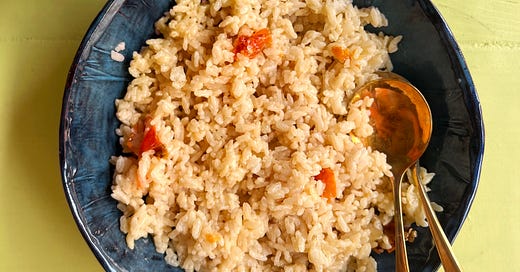





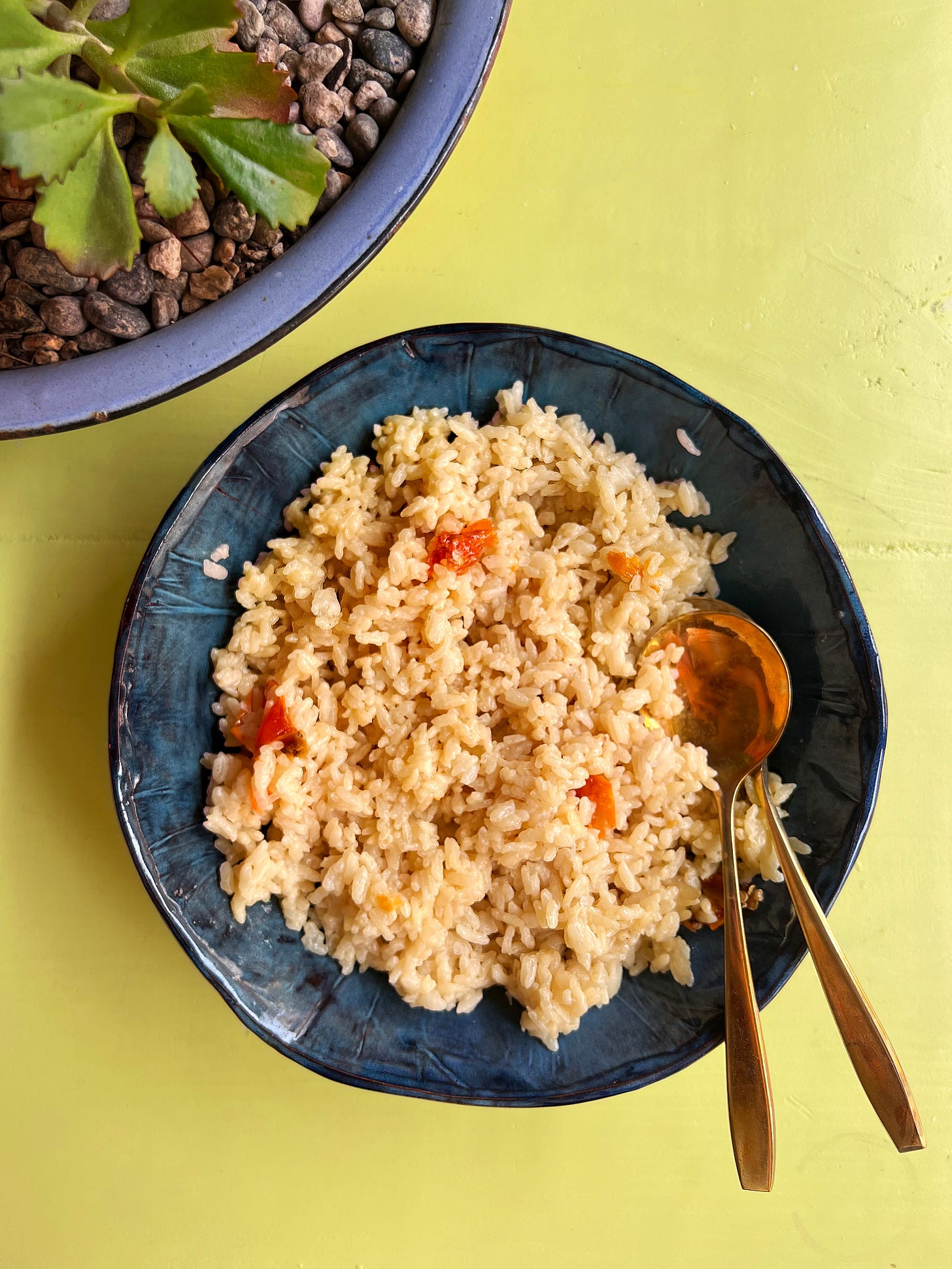
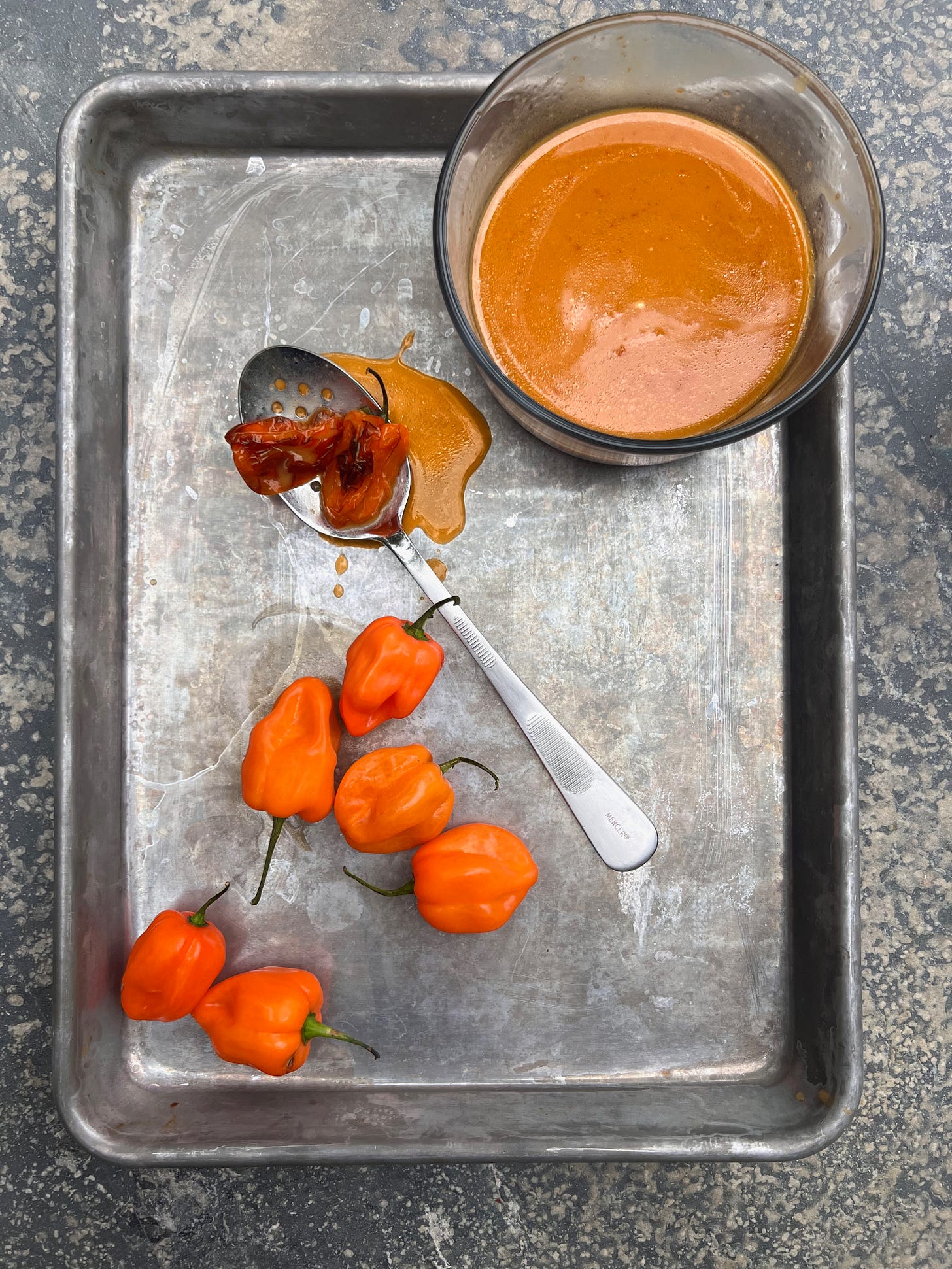
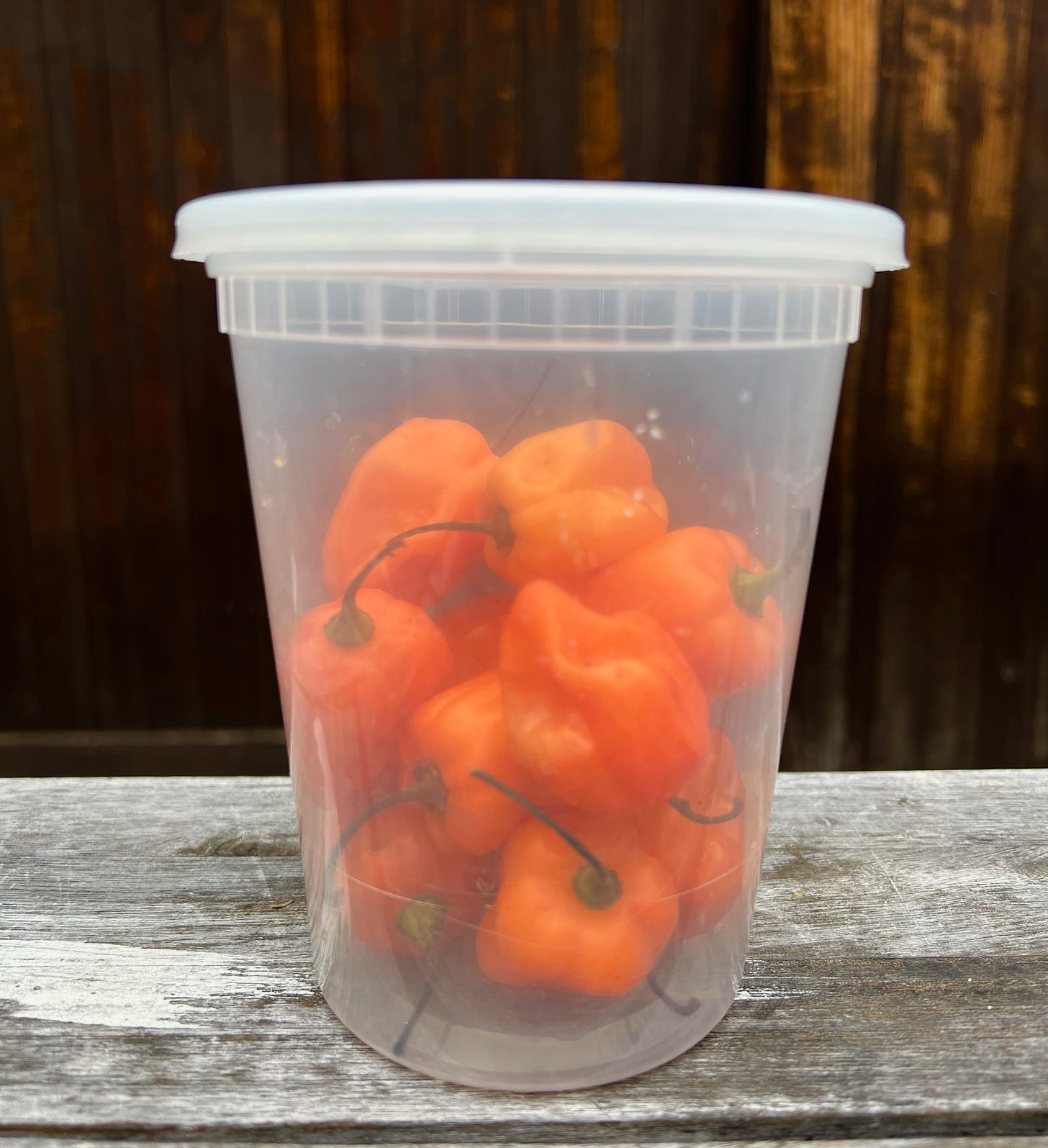


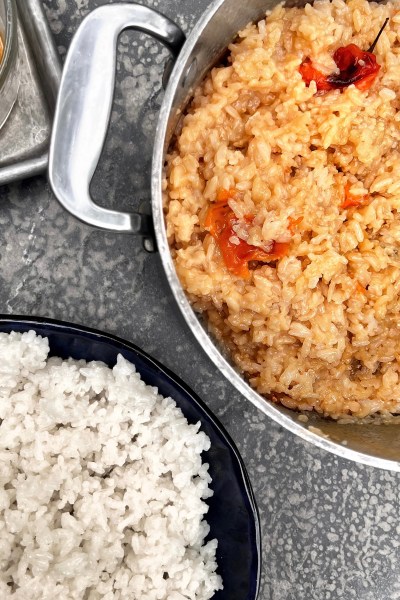
I'm really enjoying your newsletter! And am super interested in the effect of the starchy water on the plants...
I love that short-grained rice and happened upon fifteen pounds' worth of packages at my grocery store that were marked 1/2 price -- snapped them all up and am storing them in a 5 gallon-bucket in the pantry, because *rice lasts forever* -- winning!
I, too, am a sucker for coconut rice. I, too, am one of the dips who steams the coconut milk in the rice. I do this in the InstantPot and on the stovetop, knowing the coconut milk is probably going to scorch (again), resulting in me scrubbing the bottom of the pot for twenty minutes after dinner because I have a physical allergy for leaving dishes in the sink.
This is a revelation--both method and habanero honey gastrique! I can’t wait to try this! (especially cold?!) I’m a basmati die-hard, never tried Calrose. That’s about to change.
(PS I will see your Reusing Water and raise you a Grease Cup that lived by our stove my entire childhood. Nothing will make you ponder the state of your arteries as quickly as that. File this under: “Tell me you live in the South without telling me you live in the South.”)